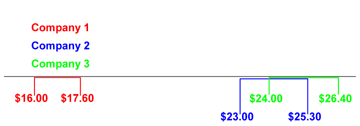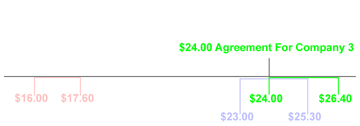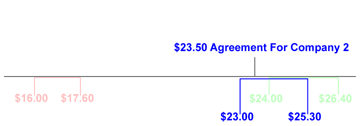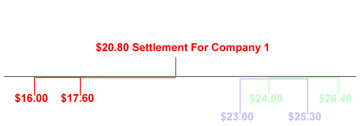Labor negotiations are entered on the Human Resources spreadsheet. Negotiations can be viewed as exception events– sudden changes in the operating environment. Labor opens the contract offers from all of the companies, picks the most favorable terms, and uses them as a standard for negotiation with every company. This creates an opportunity for a low labor-cost company (due to automation and other investments) to impose higher labor costs upon other firms.
After reviewing this section, test your knowledge by clicking Labor Quiz to the left.
Labor and management negotiate over four separate categories:
- Hourly Wage
- Benefits
- Profit Sharing Percent
- Annual Raise
If the current contract expires during the year, your company establishes a bargaining position that is bounded by a Starting Position and Negotiation Ceiling.
The Starting Position (first) wage offer cannot be less than 80% or more than 150% of your current contract. The Starting Position for Benefits, Profit Sharing, and Annual Raise can be between 0% and 150% of your current contract.
The spreadsheet automatically enters a Negotiation Ceiling that is 10% above each Starting Position.
Each company will have its own Starting Position and Negotiation Ceiling for the four categories. The example below shows Hourly Wages Starting Positions and Negotiation Ceilings for three companies (figure below):
- Company 1 has a Starting Position of $16.00 and a Ceiling of $17.60;
- Company 2 has a Starting Position of $23.00 and a Ceiling of $25.30;
- Company 3 has a Starting Position of $24.00 and a Ceiling of $26.40.

Labor will ask for a 10% across the board wage and benefit increase. For example, if the wage were currently $20.00 per hour, labor demands $22.00 per hour.
However, if any of the Starting Position offers is higher than the 10% increase, labor will adjust its demand upward to match it. Company 3’s Starting Position for wages is $24.00, therefore labor now demands $24.00 from all companies. Labor accepts Company 3’s offer of $24.00 per hour (figure below).

If labor’s demand is within the company’s Starting Position and Negotiation Ceiling, negotiations lead to an agreement. Company 2’s negotiators have instructions to issue a Starting Position of $23.00 and a Negotiation Ceiling is $25.30. Company 2’s negotiation range brackets labor’s demand. They will agree at $23.50, halfway between the $23.00 Starting Position and labor’s demand of $24.00 (figure below).

Company 1’s Negotiation Ceiling is $17.60. If the top of the Negotiation Ceiling is below labor’s demand, labor strikes. At the end of the strike the two sides will settle halfway between the company’s Negotiation Ceiling and labor’s demand, or at $20.80 (figure below). Strike lengths depend on the spread between positions.

The maximum length of a strike is 84 days, at which point both sides accept arbitration. Workers will strike approximately seven days for every:
- $1.00 difference in wages
- $300.00 difference in benefit package
- Percentage point difference in Profit Sharing
- Percentage point difference in Annual Raise
Table 7.1 illustrates a strike example. Strikes always occur at the end of the year. If a strike is 46 days long, workers would picket from the middle of November to the end of December.
If you have inventory on hand during the strike, sales continue. R&D projects also continue.
7.3.1 Tactics
You will need to determine which negotiation tactics best serves your purposes. Companies with low automation will want to control labor costs. They could offer the lowest acceptable wage, which is 80% of the current contract and eliminate all benefits. Companies with high automation might choose to be extremely generous with their workers, which will impose higher costs on their competitors (remember, labor looks at all offers and makes the highest offer part of their demand).
If a low wage/benefit tactic is employed, the labor turnover rate (and therefore recruiting costs) will increase. Also, if the Human Resource Module is activated, gains to the productivity index might be erased (see 7.2 Human Resources).
The Human Resources area automatically calculates Negotiation Ceilings that are 10% above the Starting Positions.
|
Table 7.1 Example of a Negotiation Position and Resulting Strike Time: Note that the Annual Raise is 0% to 0%, this is because 110% of 0 is 0 |
|||||
|
|
Starting Position |
Negotiation Ceiling |
Demand |
Contract |
Approximate Strike Days |
|
Hourly Wage |
$18.00 |
$19.80 |
$22.00 |
$20.90 |
15 |
|
Benefits |
$2,500 |
$2,750 |
$2,750 |
$2,625 |
0 |
|
Profit Sharing |
1.5% |
1.7% |
2.2% |
1.95% |
4 |
|
Annual Raise |
0.0% |
0.0% |
7.2% |
3.6% |
50 |
|
Total Days of Strike |
69 |
||||
Login to the Capstone Web Application and click the Decisions menu. Select Human Resources to enter Negotiation Starting Positions for Wages, Benefits, Profit Sharing and Annual Raise.
